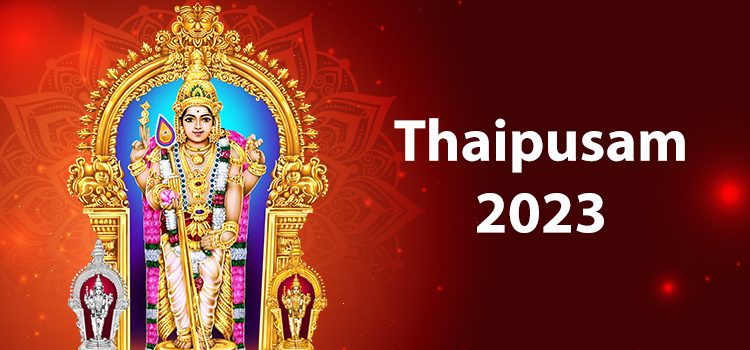In the cold winter months of January and February, one can see many men and women wearing orange or yellow clothes making their way on foot to Muruga temples in Tamil Nadu, carrying Kavadis and Paal kudams. Some of them sport piercings on their tongues, cheeks, and backs with hooks and lances. But neither do they bleed or wince in pain, and they also seem to be in a trance-like state. Yet others walk on hot coals. All these rituals are punctuated by fervent chants of ‘Vel, vel, shakti vel!’ as other devotees gather around them to witness the stirring spectacle and egg them on with their own cries of devotion. When you see such sights, you know that Tamil Hindus are celebrating Thaipusam, a festival that honors Muruga, the son of Shiva and Parvati.
Thaipusam is a blend of 2 words, ‘Thai’ and ‘Pusam’. Thai refers to the Tamil month that corresponds to Jan-Feb in the Gregorian calendar. Pusam refers to the star or Nakshatra. Thaipusam festival falls on the first full moon day in the Tamil month of Thai. It is also the day of Pusam star. Thaipusam 2024 is on February 25 (Sunday).
Significance of Thaipusam Festival
Every religious festival in India has its own meaning. Thaipusam commemorates the day Goddess Parvati gave the divine weapon ‘Vel’ (lance) to her son, Murugan, to defeat the demon Tarakasura and his army. Demons in Hindu religious thought are metaphors for negative thoughts that dwell within human beings – pride, arrogance, anger, ego, etc. Murugan’s Vel represents purity and knowledge, which are the weapons needed to destroy these negative thoughts. So Thaipusam is a time for self-purification through penance, fasting, and abstinence from the pleasures of life. By purifying the mind and body, devotees attain self-knowledge and union with the Divine.
Rituals of Thaipusam
The most important ritual is the carrying of ‘Kavadis’. Kavadi is a brightly colored, semicircular canopy that is supported by a wooden rod and is carried on the devotee’s shoulders. Pots or pails hang from it; they contain offerings to the deity like milk, flowers, fruits, etc. Devotees decorate the Kavadi with peacock feathers (the peacock is Murugan’s mount), margosa leaves, and other things. The Kavadi ritual signifies that the devotee carries his burdens to Murugan and offers it to him so that the deity can remove them from his life, thereby paving the way for a smooth and peaceful life. People also take Kavadis to fulfill vows and express gratitude for wish fulfillment.
The Kavadi-carrying tradition was inspired by an ancient Puranic legend featuring Murugan and his devotee, a demon who carried two hills. Murugan was the demon’s Ishta Devata. The deity said that those who carried an object similar to the two hills that were suspended on a load-bearing pole would be granted their heart’s desire. Thus, devotees emulate Idumban through this ritual. Another belief is that the devotee is the processional vehicle, and the Kavadi symbolizes Murugan’s shrine.
The more extreme Thaipusam rituals include piercing the body with hooks, skewers, and lances. Some even pull chariots carrying Muruga’s idol with hooks attached to their backs. Strangely, those who indulge in such practices are not harmed by the torments they subject their bodies to. The piercings take place on full moon day as it is believed that it helps to drive away evils. Turmeric, rice powder, and sandalwood paste are smeared on the body to prevent the wounds from getting infected.
Preparing for the Kavadi Ritual
The devotees who wish to carry Kavadis start their preparations 48 days (one mandala) before the festival. They begin to purge themselves of all mental and physical impurities. The austerities include:
· Controlling the senses
· Observing a total fast or eating only one simple vegetarian meal or fruits and milk in a day
· Avoiding cigarettes, alcohol, and other intoxicants
· Sexual abstinence
· Bathing in cold water
· No shaving or cutting hair
· Sleeping on the floor
· Performing continuous or morning and evening Poojas. Prayers, Japa, singing hymns, chanting Mantras, reading holy texts, and thinking of Murugan.
The day before Thaipusam, devotees observe a 24-hour complete fast. Some also observe Mauna Vrat (vow of silence).
On Thaipusam day, devotees shave their heads and walk barefoot to the temple. They wear yellow or orange clothes, as these are Muruga’s favorite colors. Carrying a pot of milk (Paal Kudam) is the simplest form of Kavadi.
On reaching the temple, devotees lay down the Kavadi. Honey or milk Abishekam is performed for the idol to express thanksgiving. They also offer yellow fruits and flowers to Murugan. On reaching the temple, the hooks and skewers are immediately removed. The wounds are then treated with hot ash.
The final ritual is Idumban Pooja, performed in the devotees’ homes. It is held up to a week after the day of the procession. With this, the strict penance and fasting in the days preceding the festival come to an end.
Thaipusam is also celebrated in countries like Malaysia, Sri Lanka, Fiji, Singapore, South Africa, etc., where there are large Tamil communities.





0 Comments